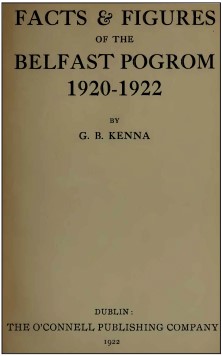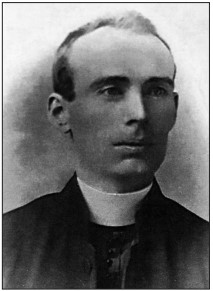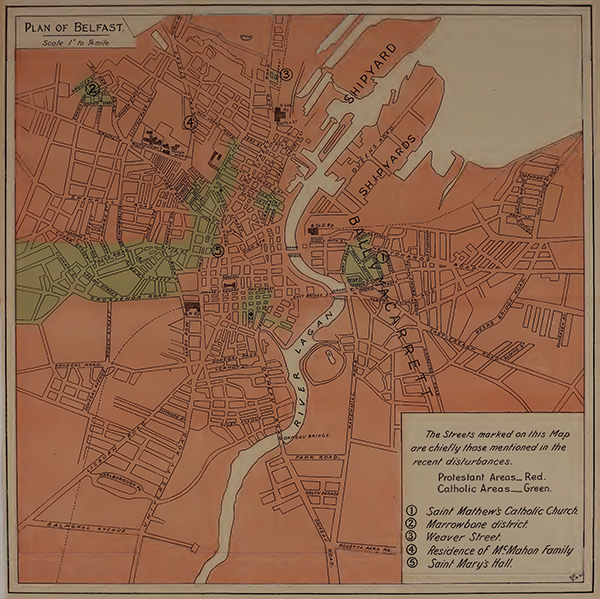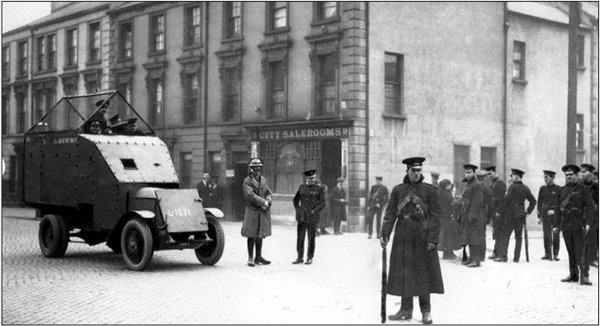Facts and fallacies of the Belfast pogrom
Published in Features, Issue 5 (September/October 2020), Volume 28An analysis of Facts and figures of the Belfast pogrom 1920–1922.
By Kieran Glennon
 In the summer of 1922, someone who was not the originally intended author wrote a pamphlet under a pseudonym; it was published by a company that may not have actually existed, and all but eighteen copies were pulped before they left the printer. Facts and figures of the Belfast pogrom 1920–1922 was intended to ‘… deal with the mountain of lies by which the entire world had been duped and the poor Catholics of Belfast choked’.
In the summer of 1922, someone who was not the originally intended author wrote a pamphlet under a pseudonym; it was published by a company that may not have actually existed, and all but eighteen copies were pulped before they left the printer. Facts and figures of the Belfast pogrom 1920–1922 was intended to ‘… deal with the mountain of lies by which the entire world had been duped and the poor Catholics of Belfast choked’.
Genesis
Belfast was gripped by politically motivated sectarian violence for over two years, beginning in July 1920—a period called ‘the pogrom’ by nationalists. By the time the Treaty was signed in December 1921 some 198 people had been killed, but worse was to come. Responsibility for policing and security in the North had been transferred from Westminster to James Craig’s Northern Ireland government the previous month and, having been demobilised in July in accordance with the Truce, the Ulster Special Constabulary was promptly re-mobilised. The violence escalated in the spring of 1922 and in March alone 69 more people were killed.
By that stage, although Catholics constituted only 25% of the city’s population, they accounted for 53% of the deaths. Michael Collins, taking a more active interest in the North since becoming chairman of the new Provisional Government, sent fellow Corkman Patrick O’Driscoll to investigate. O’Driscoll told University College Cork registrar Alfred O’Rahilly that ‘… the bishop of Down and Connor, the priests and others gave me numerous instances of how the three Belfast Orange papers had by suppressio veri and suggestio falsi misled the world as to the situation there’.

Above: Fr John Hassan, curate of St Mary’s parish in Belfast’s city centre, wrote the report under the pseudonym ‘G.B. Kenna’. (Niall Hassan)
O’Driscoll persuaded O’Rahilly that ‘From all the facts that could be gleaned a genius could write one of the most powerful indictments of Orangeism ever published’. O’Rahilly met Collins in mid-April 1922 and agreed to take on the project. At Collins’s request, the bishop of Down and Connor, Joseph MacRory, assigned the curate of St Mary’s parish in Belfast city centre, Fr John Hassan, to help compile information for O’Rahilly. Collins had encountered Hassan earlier that month as one of a combined delegation of northern churchmen, IRA officers and Sinn Féin leaders who met the Provisional Government to explain the gravity of the situation. A first draft was completed in early May but O’Rahilly was then abroad for the rest of that month. Hassan continued gathering research, while growing anxious at not having heard from O’Rahilly. Eventually, Collins agreed to fund publication of Hassan’s work under the pseudonym G.B. Kenna—the intention was that this would be an interim report, with O’Rahilly’s more comprehensive work to be published later. The ‘O’Connell Publishing Company, Dublin’, was the official publisher, although its very existence remains doubtful.
Destruction
Hassan’s foreword to the pamphlet was dated 1 August 1922, but by then the Civil War in the South was five weeks old and Collins’s Provisional Government had more pressing concerns than the fate of Belfast Catholics. On that same day it established a North East Policy Committee to review the government’s position on the North.
Among the members of this committee was Ernest Blythe, a republican from an Antrim Church of Ireland background. At one time Centre of the IRB in Belfast, and later an organiser for the Irish Volunteers in Clare, he was elected to the first Dáil as TD for Monaghan North. He had opposed the Dáil declaration of a ‘Belfast boycott’ in August 1920 as a response to the initial outbreak of the pogrom, saying that ‘To declare an economic blockade of Belfast would be the worst possible step to take. If it were taken it would destroy for ever the possibility of any union.’
On 9 August Blythe wrote to his fellow committee members, his assessment coloured by the outbreak of the Civil War:
‘Heretofore our Northern policy has been really, though not ostensibly, dictated by Irregulars. In scrapping their North Eastern policy we shall be taking the wise course of attacking them all along the line.’
He urged a complete change of policy in relation to the North, from one of aggression to one of conciliation. In particular, he urged that
‘The “Outrage” propaganda should be dropped in the Twenty-Six Counties. It can have no effect but to make certain of our people see red which will never do us any good.’

Above: The map of Belfast included in the report.
On 19 August the Provisional Government accepted the committee’s recommendation that ‘It was considered desirable that a peace policy should be adopted in regard to future dealings with the North and Ulster’. Collins was not at this meeting, although the decision was conveyed to him. Three days later he was dead.
Publication of Hassan’s work was cancelled and it is believed that only eighteen printed copies of the pamphlet survived. One was sent to Bishop MacRory and another to Joseph Devlin, Nationalist MP at Westminster for Belfast West. Another copy surfaced in 1997 and, at the urging of historian Andrew Boyd, it was used by Tom Donaldson to republish Hassan’s original document.
Facts and figures of the Belfast pogrom 1920–1922
Hassan’s dedication of the pamphlet read: ‘To the many Ulster Protestants who have always lived in peace and friendliness with their Catholic neighbours, this little book dealing with the acts of their misguided co-religionists is affectionately dedicated’.
The pamphlet largely consists of short descriptions of hundreds of incidents that occurred in the city. The vast majority of those chosen by Hassan were ones in which Catholics were the victims, including the notorious McMahon family killings and the particularly vicious murders committed by police in Arnon Street in April 1922. Interspersed with these are critical reviews of the unionist press and of the conduct of politicians in London and Belfast.
Hassan’s most venomous condemnation, however, was reserved for the Special Constabulary, whom he described as ‘… local men, recruited for the most part from the dregs of society, brought up from their earliest years in an atmosphere of anti-Catholic bigotry, taught both by their political and religious leaders that their Catholic neighbours are their only enemy, and inflamed by the subtle innuendoes and brazen lies of the most malignant Press in the world’.
His prose could be florid and emotional, ‘… the pogromists broke loose on their fiendish work in Belfast’ being a typical example. By the time the northern government was established in June 1921, ‘Already for practically a whole year, the Catholics of Belfast and of many other places had been suffering at the hands of who now demanded their allegiance and co-operation the agonies of a wholesale persecution such as no Christians in any part of the world outside Turkey have been subjected to in modern times’.
His style bears interesting comparison with that of another priest, Patrick Gannon, who wrote an article, ‘In the Catacombs of Belfast’, for the Jesuit journal Studies in June 1922. Gannon observed of the city’s Catholics: ‘By day they are at the mercy of the lonely apache with a revolver in his pocket or the mob which wants to drive them from their employment; by night they live in terror of the Specials, who are now their most dreaded enemies’.

Above: Military and police at the junction of May Street and Joy Street on 23 March 1922, following the killing of two Special Constables. That night, in reprisal, the police committed the McMahon family murders. (Belfast Telegraph)
Hassan’s work was clearly intended as propaganda for an international audience. He particularly highlighted violence inflicted on Catholic ex-servicemen, pleading that, having served the Empire in wartime, they now deserved protection in peacetime. Considering his clerical background, it is not surprising that he also emphasised the frequent attacks on Catholic churches and presbyteries, particularly those on St Matthew’s in Ballymacarrett (‘1’ on the map).
The IRA, however, is mentioned only four times in the entire pamphlet: twice in a letter from Craig to Collins quoted by Hassan, once in the text of the second Craig–Collins Pact, which Hassan reproduced in full, and only once in his own text. He cannot have been unaware of IRA activity. During the Truce, they had used St Mary’s Hall, mere yards from his church in Chapel Lane, as their ‘truce liaison office’, and a police raid on the hall in February 1922 captured documents listing many IRA members who had attended training camps.
Fatalities
The part of Hassan’s pamphlet that has been cited most often by subsequent historians is his list of 455 people—267 Catholics, 185 Protestants and three ‘unascertained’—who were killed in Belfast from July 1920 to June 1922. An identical but handwritten list was included by the Brigade Committee of the IRA’s Belfast Brigade among their submissions to the Military Service Pensions Board in the 1930s, so a copy of the pamphlet was evidently then in circulation in Belfast republican circles.
In his list, however, Fr Hassan is guilty of both sins of commission and sins of omission. The victims of a number of accidental shootings are included; these involved the children or friends of policemen killed when service weapons were unintentionally discharged in their homes, while another involved a Private ‘Arthur Boundary’—recte Frederick Bundy—fatally shot in a barracks when a fellow soldier was cleaning his rifle. Counting these as victims of the pogrom is at least questionable.
‘Constable’—actually Sergeant—Sam Lucas is listed as having died on 4 November 1920; Sergeant Lucas had been wounded in Tempo, Co. Fermanagh, however, so while he died in Belfast from violence, he did not die from Belfast violence. William Bell is listed as having been killed on 1 December 1920, but he did not die from political violence at all: a contemporary newspaper report describes how a wall collapsed on the unfortunate Bell during a thunderstorm. (History does not record whether it was a Protestant wall or a Catholic wall.)
Much more seriously, Hassan’s list fails to include the three Protestants killed in Corporation Street on 22 November 1921, when the IRA threw a bomb into a tram carrying shipyard workers home. The attack itself is mentioned in passing in the text, but to omit the names of the victims of the IRA’s first such indiscriminate sectarian attack is a huge failing. Two days later, a second tram, bound for the Shankill Road, was bombed on Royal Avenue and four killed—but their names are included.
What historians say
So, if Hassan’s figure of 455 dead is wrong, whose figures are right? How many people actually died during the Belfast pogrom? Belfast local historian Joe Baker built on Hassan’s work to create a list of fatalities in his 2003 pamphlet The McMahon family killings. His total was 469 deaths, but his work imported many of Hassan’s errors outlined above. In The Northern IRA and the early years of partition 1920–22, Robert Lynch supplemented Hassan’s list with some newspaper figures to arrive at a total of 464 deaths.
Peter Hart had two different figures in his The IRA at war; he quoted a figure of 409 based on press reports in the Irish Times and Freeman’s Journal but, using additional sources, had a higher figure of 470 for a slightly shorter time-frame. Alan Parkinson’s Belfast’s unholy war had the most comprehensive account, based on all the Belfast newspapers. His figure is 498 deaths from July 1920 until October 1922, and the individual circumstances of these are recounted in his book.
This author cross-referenced these various lists and supplemented them with references in the various Belfast newspapers and in archive material relating to the Provisional Government’s North East Boundary Bureau. Accidental deaths were set aside and any name had to be corroborated by at least three sources to be included: the final figure of deaths arrived at from this process was identical to Parkinson’s 498.
This total includes four British military personnel, twenty RIC and RUC members, thirteen Specials and 181 Protestant civilians; on the nationalist side there were 23 IRA deaths, a further six from Na Fianna and 254 Catholic civilians. Successive releases from the Military Service Pensions Collection (MSPC) have revealed, however, that some deaths previously thought to have been those of Catholic civilians were in fact those of members of one of the republican organisations. As further material from the MSPC becomes available, it is possible that the numbers on the nationalist side will need to be adjusted again.
Conclusion
Despite the variations between these figures, they paint a common picture: Catholics accounted for only a quarter of Belfast’s population but suffered over half the fatalities of the pogrom—in short, they suffered disproportionately. Similarly, while criticisms can be levelled at Hassan’s work, the central argument of his pamphlet remains valid: from the initial workplace expulsions of July 1920 through to the subsequent evictions, house-burnings, woundings and—above all—killings, the overwhelming majority of the political violence in Belfast in the pogrom period was perpetrated against Catholics and nationalists. Suppressing the publication of Facts and figures of the Belfast pogrom 1920–1922 allowed their plight to be quietly forgotten by the Provisional Government.
Kieran Glennon is the author of From pogrom to civil war: Tom Glennon and the Belfast IRA (Cork, 2013).
FURTHER READING
J.A. Gaughan, Alfred O’Rahilly—public figure (Dublin, 1989).
J. McDermott, Northern divisions—the Old IRA and the Belfast pogroms 1920–22 (Belfast, 2001).
A. Parkinson, Belfast’s unholy war (Dublin, 2004).
E. Phoenix, Northern nationalism: nationalist politics, partition and the Catholic minority in Northern Ireland 1890–1940 (Belfast, 1994).
















